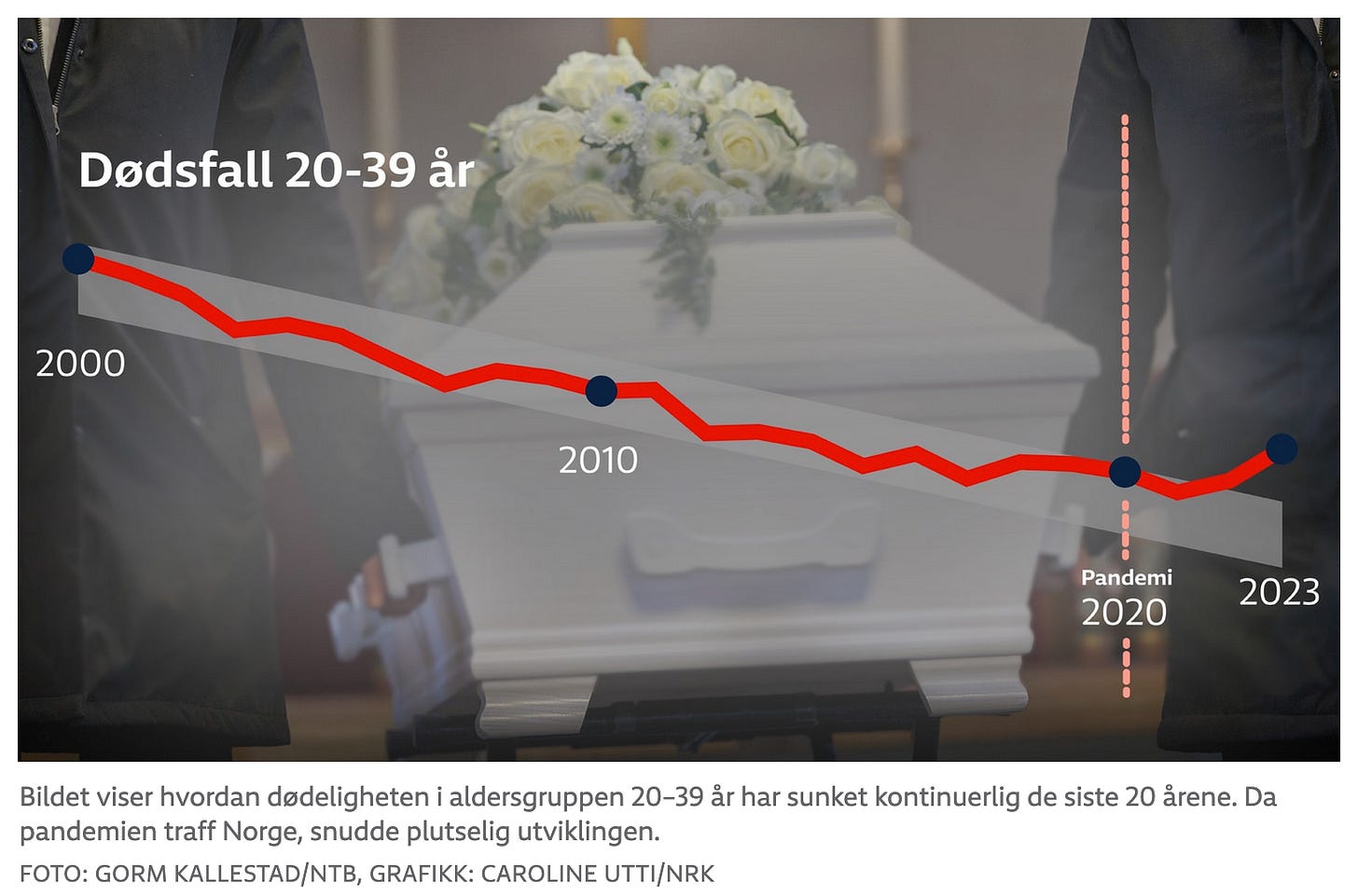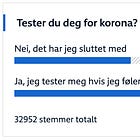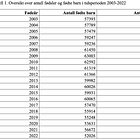'I've never seen anything like this': Excess Mortality Among Young People in Norway
State broadcaster NRK notices a worrying sign and asks 'the experts™' over at the Institute of Public Health: bafflement ensues.
Today, I’ve got a particular gem for you: alarmed yet baffled experts who don’t know why what is happening is happening. You’ve seen it all, you think? Well, here’s my ‘not just yet’ pitch, courtesy of Norwegian state broadcaster NRK.
First things first, though: two links to some of the issues we’ll be discussing below:
Joel’s main conclusion: ‘Since the mRNA experiment, on average fourteen times more COVID, three times more hospitalisations and three times as much death.’ Remember, that the reporting of more or less accurate (ahem) data stopped well over a year ago, hence ‘we, the people’, cannot possibly know more about this than public health officialdom.
Speaking of death and Covid, we note, second, that for Norwegian public health officialdom, a ‘Covid-associated death’ is ‘defined as deaths where COVID-19 is indicated as an underlying or contributing cause on the death certificate’ but, from autumn 2023 onwards, also included deaths without a positive test are now also’. Let that sink in.
Of course, there were people ‘on the internet’ who tried to report on the gruesome toll labelled ‘Covid’ early on. In 2022, Norway’s excess mortality was already elevated:
and it continued to remain higher than anticipated in 2023, as ‘provisional’ numbers suggest to which we now turn.
Translation, emphases, and bottom lines mine. IPH = Norwegian Institute of Public Health.
Responding to high death tolls among young people
By Jan-Erik Wilthil, NRK, 3 March 2024 [source]
For the first time in at least 20 years, excess mortality among young people in Norway has been recorded. This is shown by calculations carried out by researchers: ‘I have never seen anything like it’, says IPH statistician Richard Aubrey White.

For eight years, Richard Aubrey White was responsible for IPH’s statistical monitoring of excess mortality in Norway. Now he has seen something that worries him:
We have had a clear continuous decline in mortality among those under 60 in the period from 2000 to 2019. Now it seems that this trend has reversed.
He believes it could be several hundred deaths among Norwegians at a relatively young age. White emphasises that he is speaking as a researcher and not on behalf of IPH [I get the same reaction when I email with IPH personnel].
Largest Impact Among Young People
When the Covid mandates ended two years ago, something happened to the mortality rate in Norway. In 2022, an excess mortality of 11.5% was recorded, which corresponds to 4,682 more deaths than expected.
At the time, Covid-19 was the main cause of record high death tolls, and for the first time in many years, life expectancy was adjusted down in Norway.
Now it turns out that the excess mortality also continued in 2023, and this time it is not only the oldest who are dying to a greater extent than expected.
Figures obtained by NRK show a significant excess mortality also in younger age groups.
The graphs below show the development since the turn of the millennium.
The blue dots within the grey field mark a mortality that is not higher than expected. The red dots mark excess mortality.

The trend so far has been a continuous decline in mortality in all these age groups. In the time after the pandemic hit Norway, the trend suddenly reversed.
According to the calculation, this is a total of 796 more deaths than the trend before the pandemic would indicate. This applies to the age group 0–59 years.
This figure is subject to great uncertainty, and cannot be read as a conclusion. The findings are nevertheless described as disturbing.
NRK has been in contact with several researchers who work in the field.
All confirm the same picture:
More young people died in Norway last year than was expected. In percentage terms, excess mortality is highest in the age groups 0-19 and 20-39 years.
Among the very oldest, the excess mortality is not as clear.
Pointing to Covid-19
These figures say nothing about the causes of death. Researcher Richard Aubrey White nevertheless believes that Covid-19 stands out as a likely explanation [well, no need for a Covid ‘test’ or the like is required to be labelled a ‘Covid-associated death’].
A large American study shows that those who undergo a mild illness have an increased risk of death for 180 days after the infection. Another study shows that you are also exposed to a risk the next time you are infected [maybe, but we’re no longer ‘testing’, ‘asymptomatic spread’ is baaaack, and we don’t know who had Covid, so…what are we learning here?].
He fears that repeated waves of infection will harm public health:
To put it in context: 5 million Norwegians are infected every year [presumably with Covid]. Over the course of five years, we are talking about 25 million infections [remember: this is a statistician using linear projection here]. It takes very little before this has consequences for society [hat-tip to
]. By comparison, every Norwegian is only infected by the flu every five years [so, Covid isn’t like the flu, as the IPH has been saying?].
The Norwegian Institute of Public Health includes after-effects of Covid-19 to a small extent in its risk assessment. In the infection prevention advice, most emphasis is placed on the acute effects of Covid-19, which lead to admission to hospital, the intensive care unit, or death.
‘An infection control strategy that does not take late effects into account is not viable’, says Richard Aubrey White, researcher and statistician [this is nonsense: infection-control measures are designed to, well, prevent infections, as opposed to the taking care of post-infection sequelae…]
The so-called cause of death register will not be ready until the summer. Only then will it be possible to get a definitive answer to what has caused the excess mortality [I doubt this very much, if only because of the fuzzy definition of ‘Covid-associated deaths’, as I’ve discussed at some length here]
‘Studies show that Covid-19 causes a higher risk of, among other things, heart disease, diabetes, neurological diseases, depression and even suicidal thoughts. I think we will see an increase in deaths from several different diseases’, says White.
The researcher has previously pointed out a dramatic increase in the number of doctor visits for exhaustion during the pandemic.
Recent figures from NAV [unemployment/social welfare office] show that sick leave increases most among young people in their 20s, and that sick leave due to exhaustion continued to increase in the last quarter of 2023.
This week, Norwegian researchers published a study showing that those who have had Covid-19 had worse memory after the disease than they had before they got sick [haven’t looked at that paper yet].
IPH Confirms Excess Mortality
The Institute of Public Health also confirms that higher death rates among young people are sometimes recorded [note the word ‘sometimes’, like, ‘people sometimes catch a cold: talk about normalising this]
‘There have been periods in 2023, as in 2022, of excess mortality in both older and younger age groups’, says specialist director [orig. fagdirektor, i.e., section chief] Hanne Gulseth at the IPH.
She emphasises that calculating mortality is a complex field, and that there are uncertainties in such calculations [sure, no doubt, but shouldn’t we TF figure out what’s excessively sending young (!) people 6 feet under rather than equivocating?]:
As there is a lower number of deaths among the younger age groups, fewer deaths are needed before we see a higher than expected mortality in these age groups [I literally don’t understand this sentence; orig. ‘Ettersom det er et lavere antall dødsfall blant de yngre aldersgruppene, skal det færre dødsfall til før vi ser en høyere dødelighet enn ventet i disse aldersgruppene’. Perhaps Norwegian native speakers can weigh in here?]. We therefore need more in-depth analyses of mortality in 2023 by age group and gender. The results of these analyses will be published in a report in a couple of months.
[NRK] IPH has investigated whether there is any connection between vaccine and mortality. What do these analyses show?
[Gulseth] We have no evidence that the Covid vaccines cause increased general mortality in the population. On the contrary, research studies show that the vaccines are effective and protect against serious disease and death from Covid-19 [that might very well be; Brian Mowrey calls this ‘severe efficacy’, but I’d add that this doesn’t change the fuzzy definition issue mentioned above].
Recently, the world's largest study on side effects of the vaccine was published. The study had 99m participants from several countries, and revealed several serious but relatively rare side effects.
The researchers concluded that the benefit of taking the vaccine was much greater than the risk of side effects.
IPH ‘Will not Speculate’
Gulseth believes it is too early to speculate on possible causes for excess mortality:
A coincidence of events in time is not the same as causation. It is therefore important not to conclude that increased mortality in a population is due to simultaneous infection or vaccination, without this having been scientifically investigated using good methods [which are…?]
The section chief points to other changes that may have affected Norwegians' health during the pandemic.
In the most acute phases of the pandemic, for example, check-ups for patients with chronic diseases such as diabetes or heart disease were postponed or cancelled, and many failed to seek health care for less serious ailments [sure, no doubt, but would these conditions excessively affect young people?].
According to the section chief, there were also fewer resources for preventive health work, while many people became more inactive and gained weight [speak for yourself]:
It could take years before we fully see the health effects of this, including mortality.
According to figures from Statistics Norway, 43,808 deaths were registered in Norway last year. This is a decrease from the previous year, but still significantly higher than in the years before the pandemic.
‘I see a clear rise in deaths in the 30-39 age group’, says statistician Anders Sønstebø at Statistics Norway. He does not rule out that this will affect life expectancy in Norway:
When more young people die, more years of life are lost. It has a greater impact than when it comes to the elderly.
Nakstad won’t Rule Out Covid-19
The situation is not unique to Norway. Several other western countries are also experiencing a similar development. In the United States, researchers have observed an increase in cardiac deaths among young people.
In England, a study has revealed a high excess mortality in the 20-64 age group.
In Germany, the Minister of Health [Lauterbach, of all people] has warned of an increased incidence of cardiovascular diseases in the age group 25 to 50 throughout Europe.
Assistant Director of Health Espen Nakstad does not rule out that the pandemic could be the cause:
I am concerned if this is an expression of an increasing trend in the age groups up to 59 years. We cannot rule out that Covid-19 still affects mortality in Norway [hard to say in the absence of reliable ‘testing’ and, more importantly, the fuzzy category of ‘Covid-associated death’], including through long covid effects, but there may also be other factors at play.
According to Nakstad, the Directorate of Health will now survey possible causes:
We will try to map whether these changes are significant in all age groups [the statistics say they aren’t to the same extent] and whether they may have a connection with specific disease categories [like, diabetes and cardiovascular issues?]. We also have to make sure that no other external conditions [you mean, the modRNA injections?] that affect the health service can come into play. There is every reason to follow developments closely.
The health authorities estimate that a large proportion of the population will be infected by the Corona virus every year [as if ‘the Corona virus’ did not change since 2019…]. Does this put the infection prevention strategy in a new light?
[Nakstad] Our advice to the population is still to stay at home in case of illness and follow IPH's vaccine recommendations. I do not think it is beneficial to have repeated respiratory infections as frequently as we have seen in Norway in the last 2–3 years. Presumably it is not necessary to maintain good immunity either.
Bottom Lines
So, legacy media is catching up, I see. It’s almost comical that there’s a bunch of (rank-and-file) people affiliated with the IPH who ‘speak up’ (ahem) now because they see worrying things, such as, you know, the unprecedented -9% year-on-year decline in births in 2022:
With ‘excess mortality’, it’s virtually the same thing: why am I using scare quotes? Because, as pointed out above, they changed the ‘definition’. A Covid-associated death is now someone who may never have tested positive or had the illness.
We’ll also, in all likelihood, never ever going to find out about this as we’re no longer collecting these data, let alone using whatever information—esp. about the vaccination status of every resident in Norway—is available. Until and unless we place everything on the table, there won’t be anything we can learn.
So, what’s the Norwegian term for ‘limited hang-out’?
If it would help in any way, shape, or form, I’d email the journalist and suggest a few questions (esp. the ‘Covid-associated deaths’ definition), but, alas, I doubt it would do any good.
What do you think?








First comment on the Joel Smalley article you linked to:
I've sort of run out of shocked/distressed/amazed/saddened comments.
Or funny/witty/sarcastic ones.
Or angry/indignant ones.
What is there left to say? The jabbed are jabbed. It can't be undone. They presumably don't want to know what they've done to themselves. The authorities don't want them to know. The conversation has been changed to save the sanity of the gullible.
“It is difficult to get a man to understand something, when his salary depends on his not understanding it.”
― Upton Sinclair, I, Candidate for Governor: And How I Got Licked